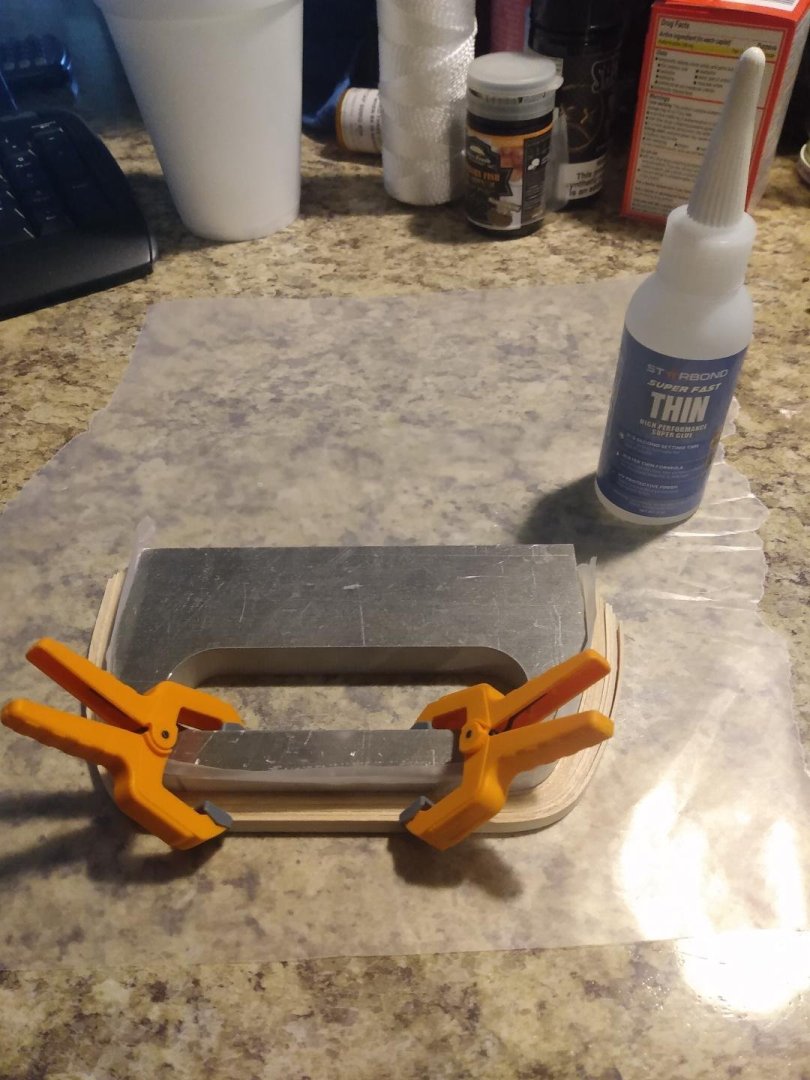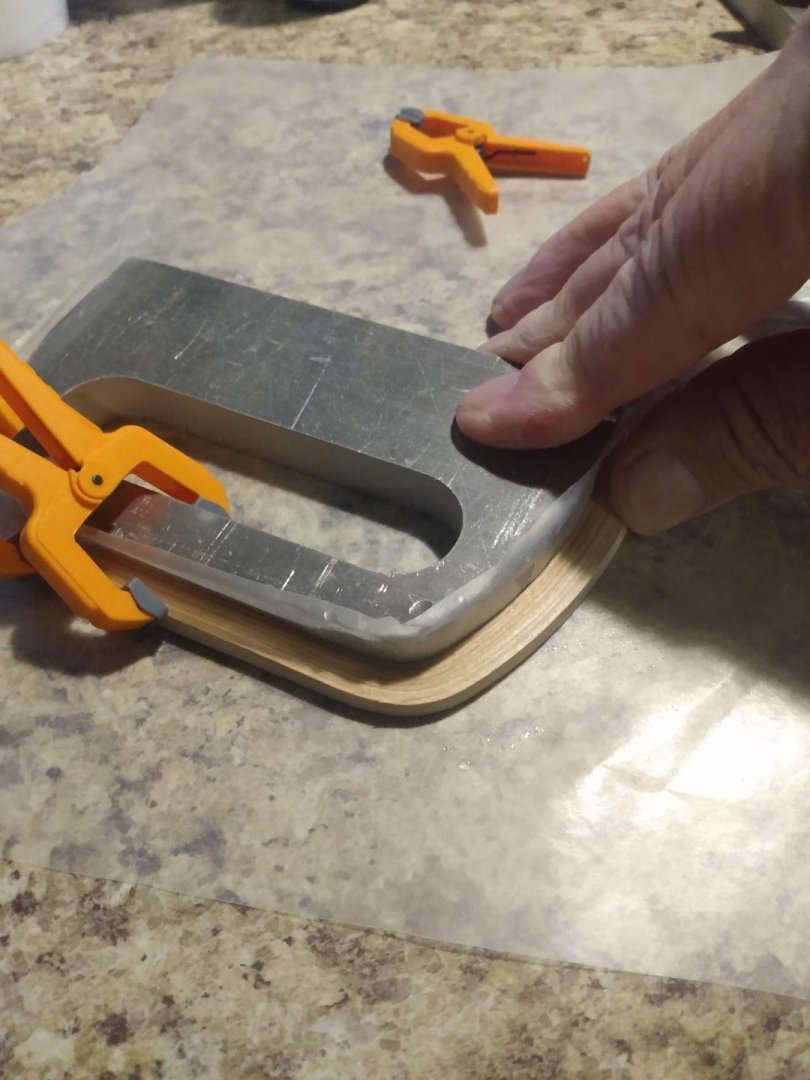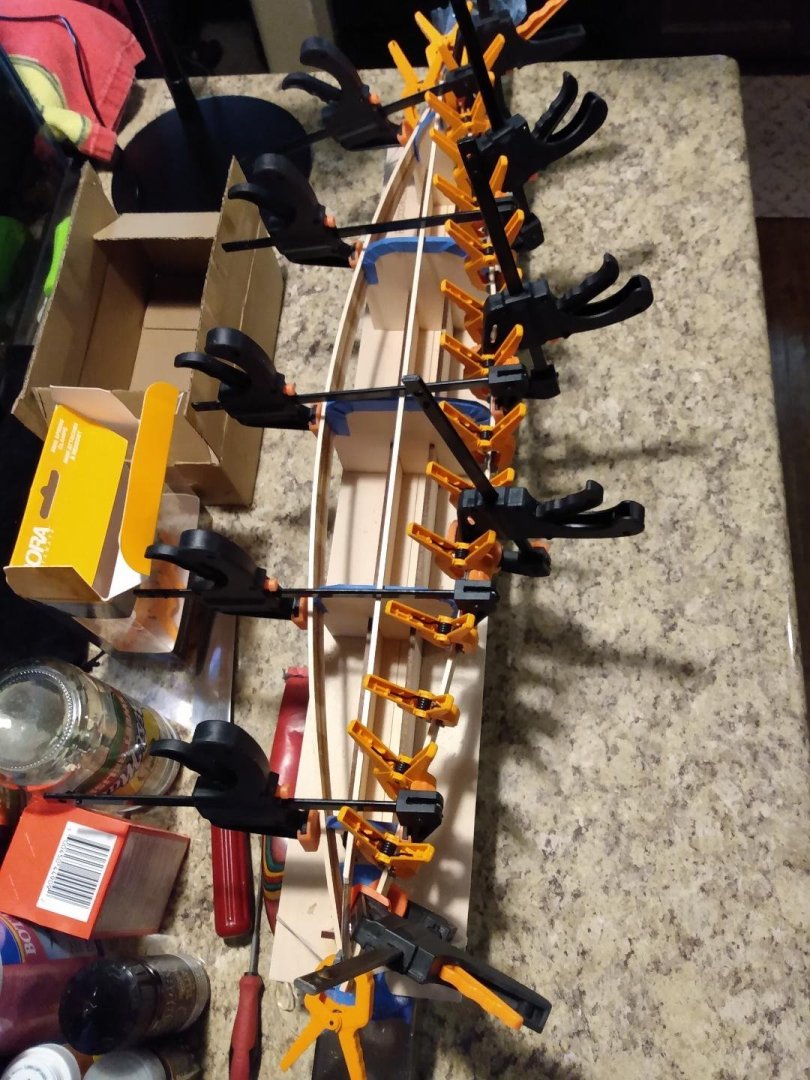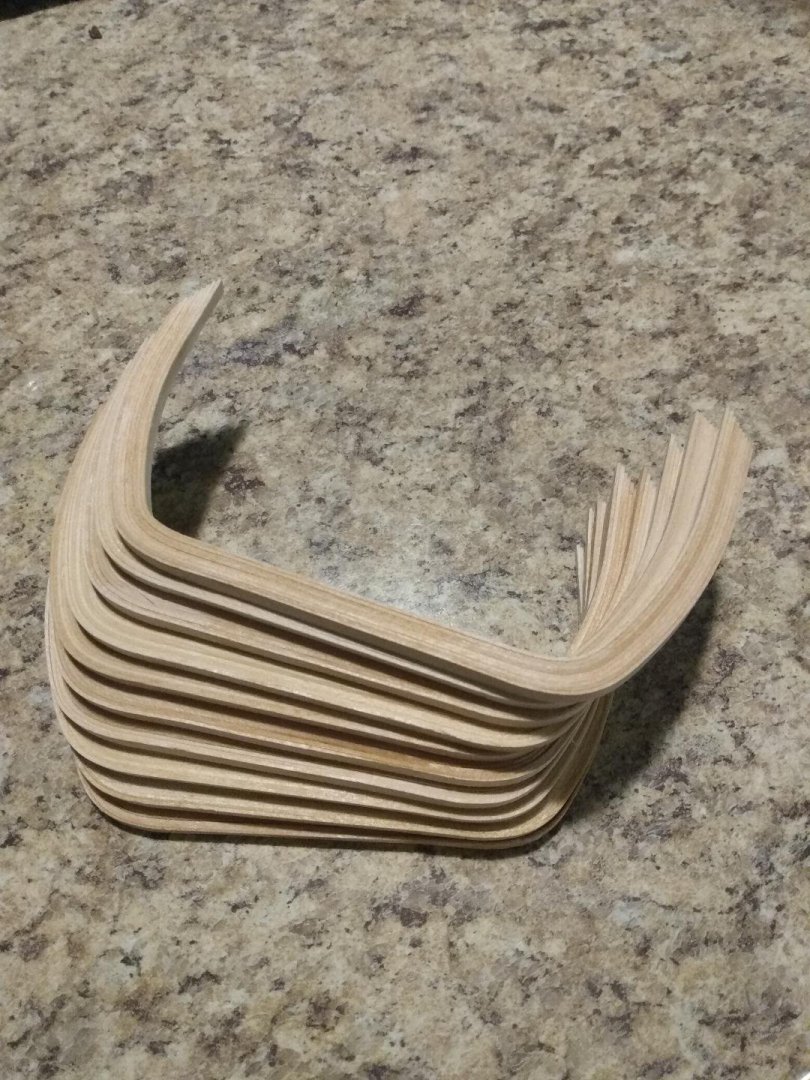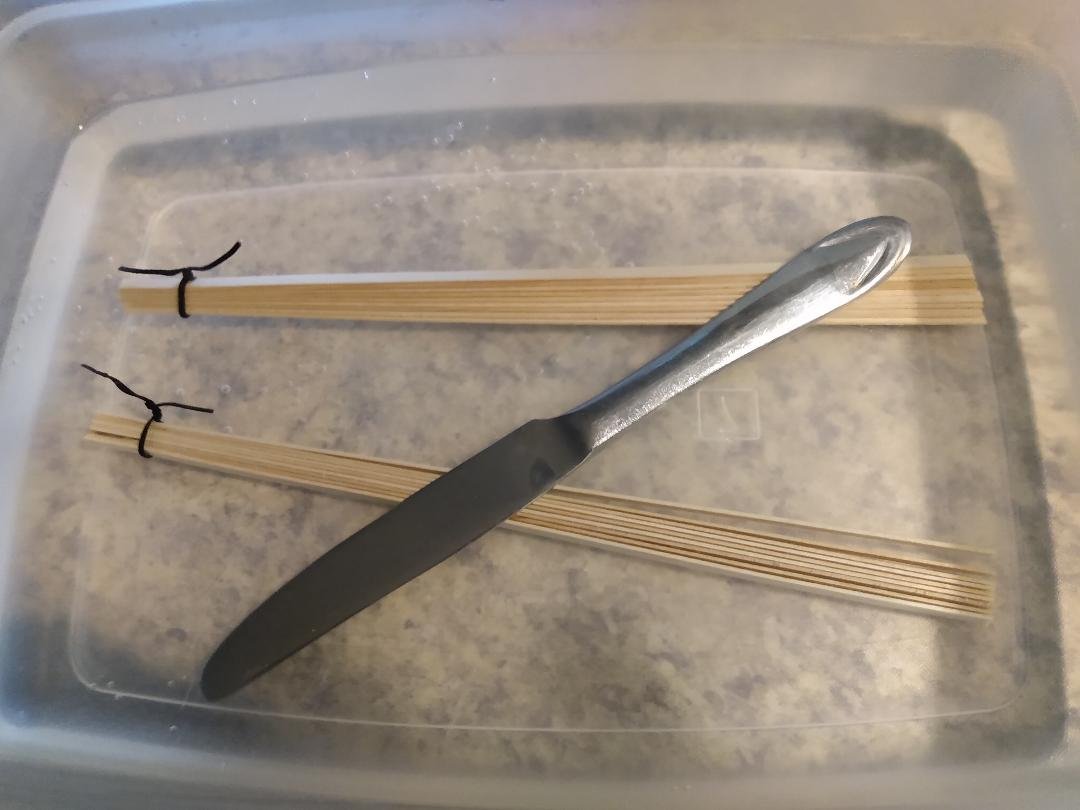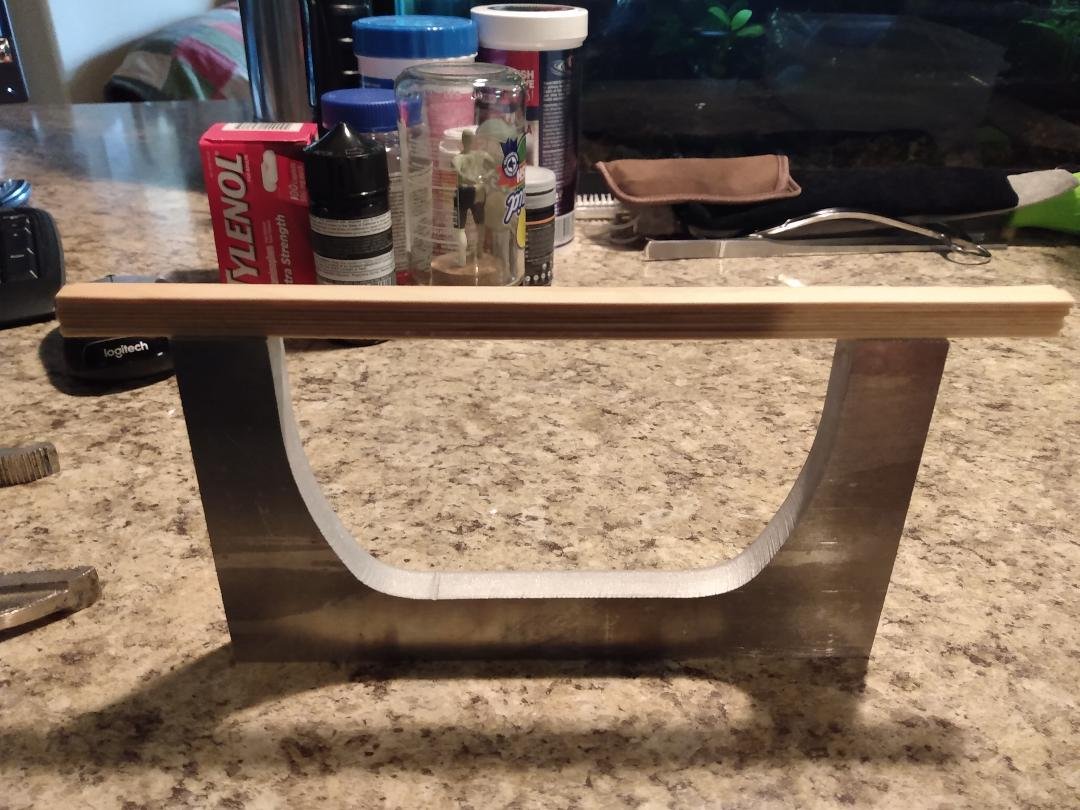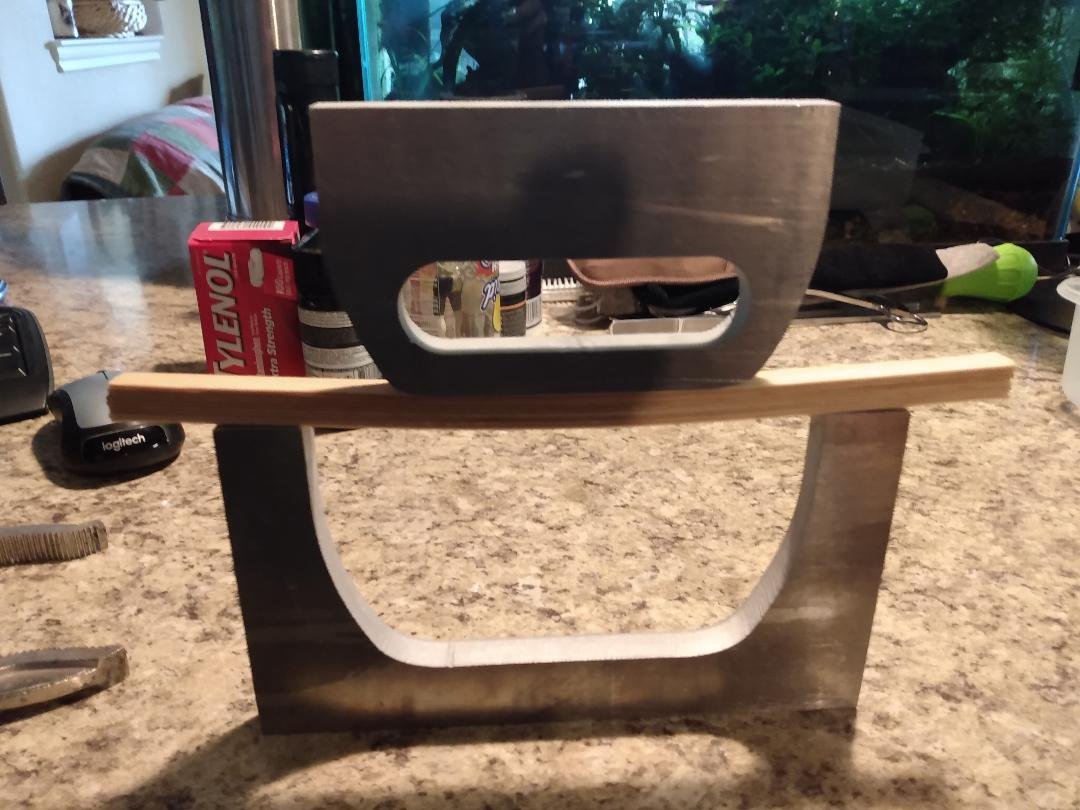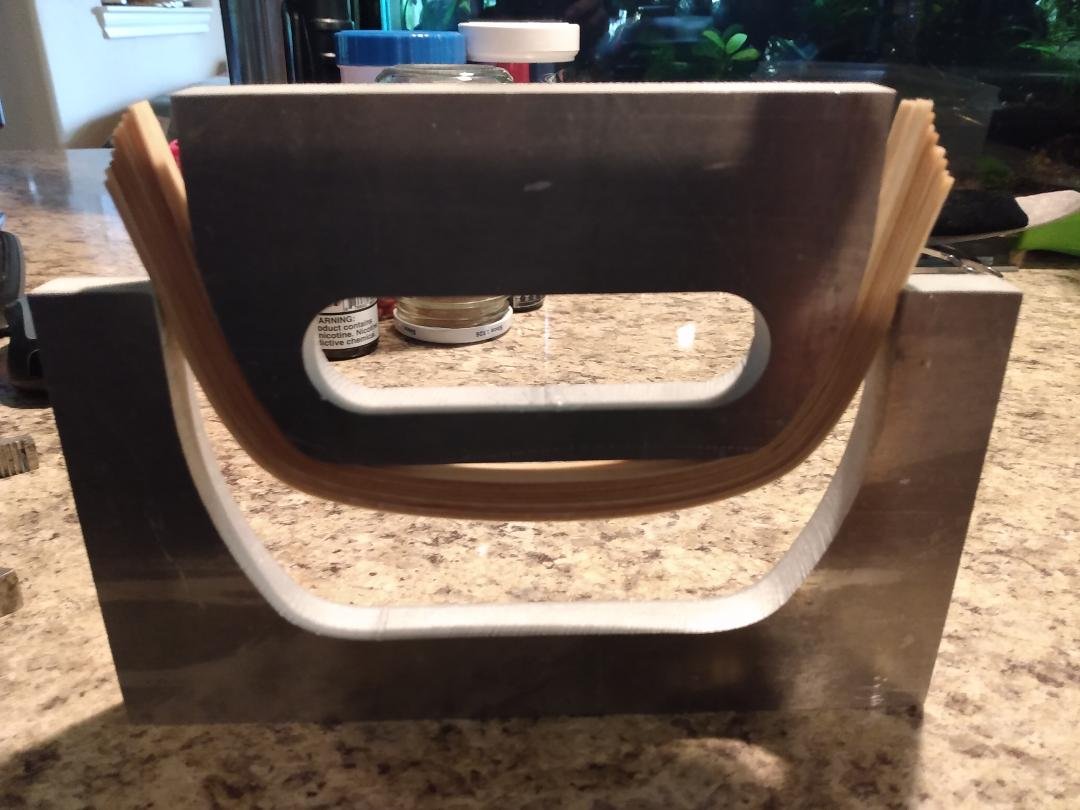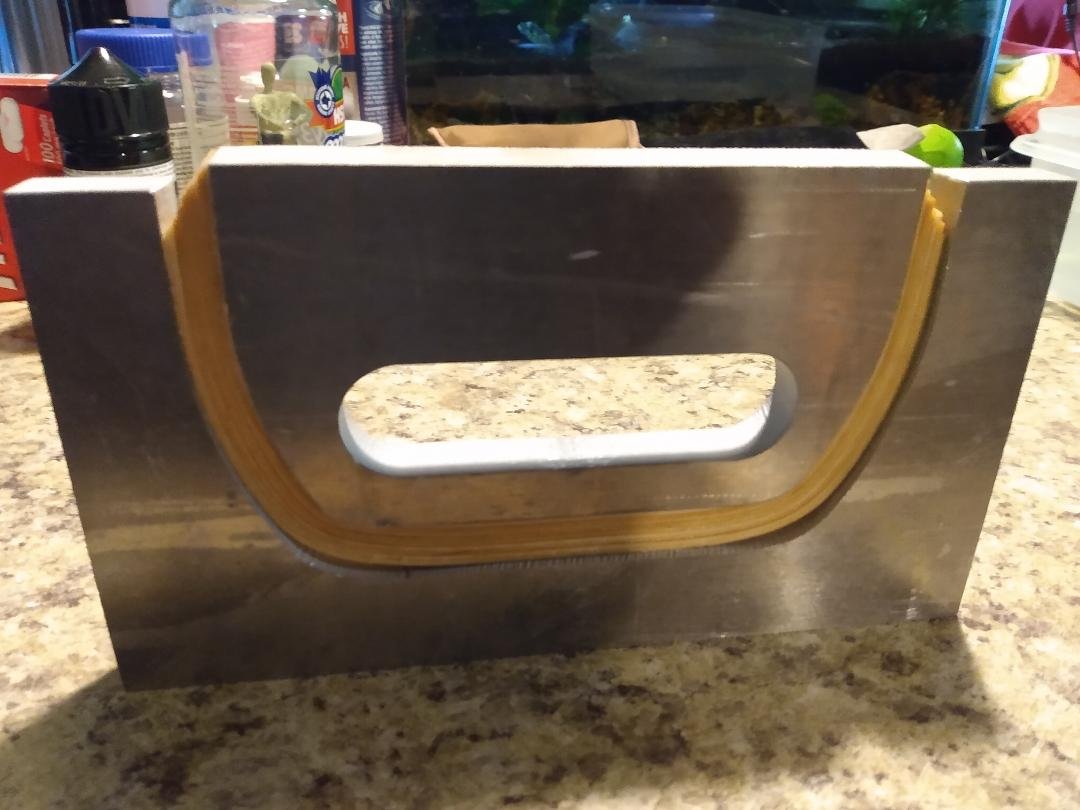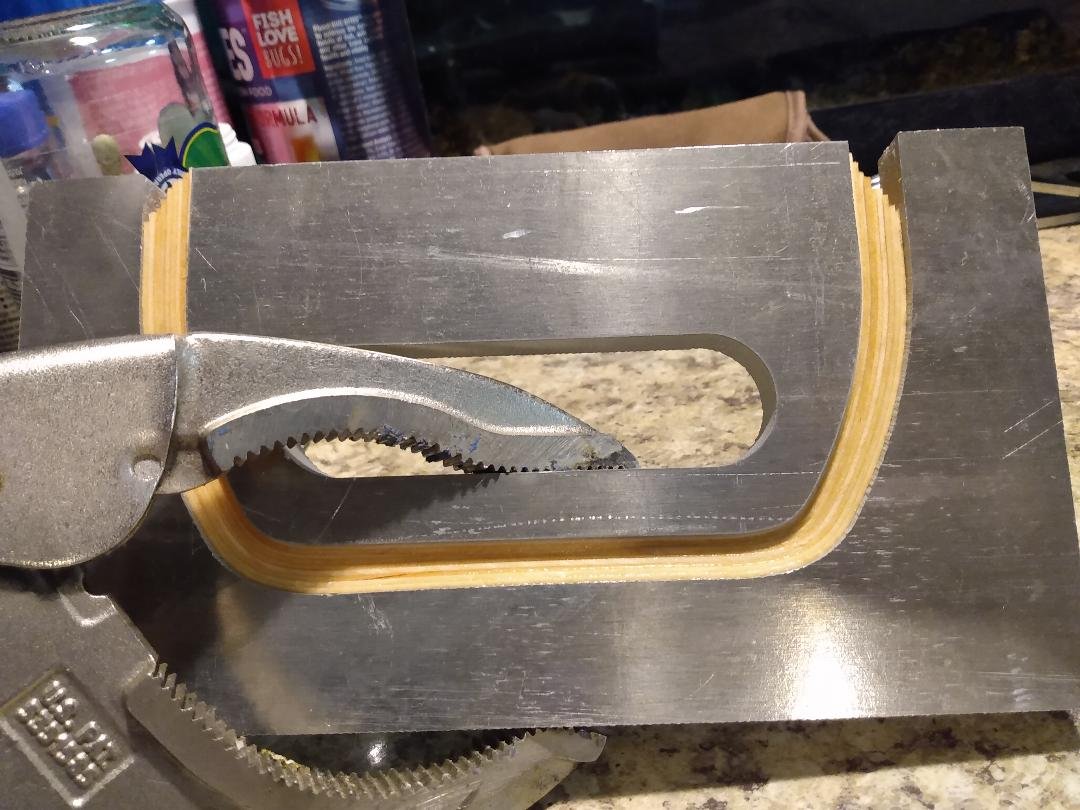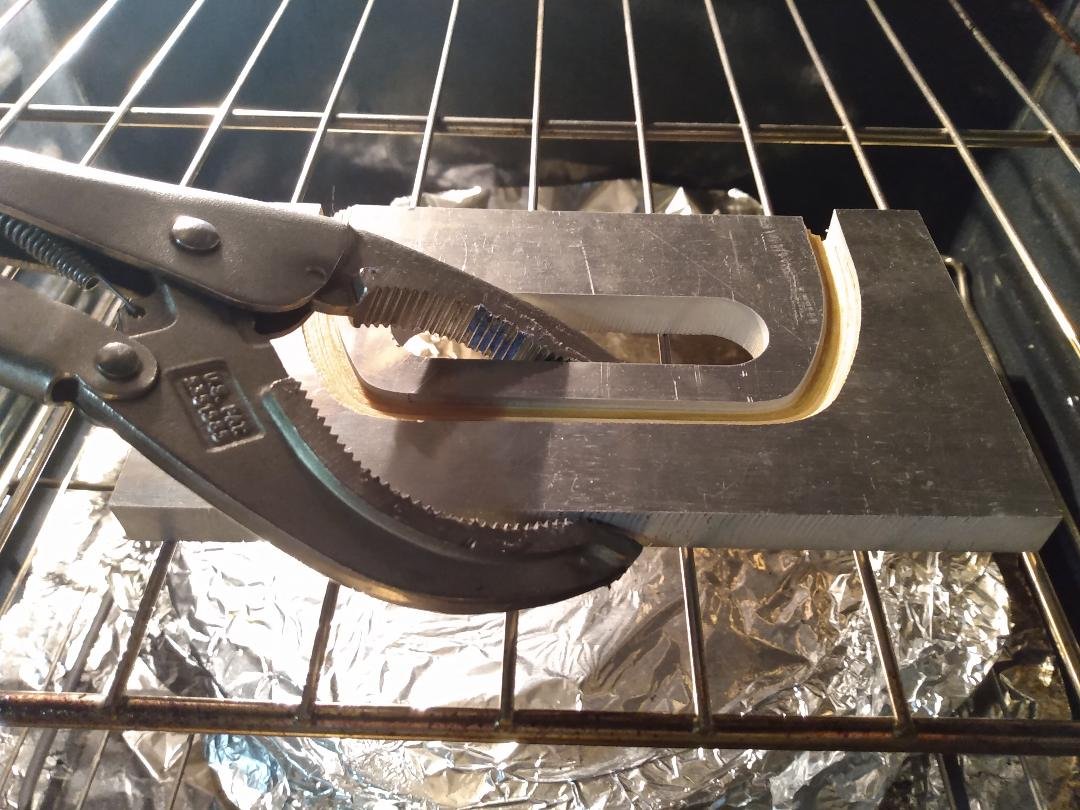-
Posts
765 -
Joined
-
Last visited
Content Type
Profiles
Forums
Gallery
Events
Everything posted by tmj
-

Gunboat Philadelphia 1776 by tmj
tmj replied to tmj's topic in - Build logs for subjects built 1751 - 1800
More work on the frames. I've now got 10 frames laminated together and ready to be cut/sanded to their final shapes. These ten sets will make 20 actual frames once all is said and done. As mentioned previously, I need 18 sets of these frames (36 actual frames) to complete the port and starboard mid-section of this build. I'll glue the remaining 8 sets together later. I normally don't like to use CA glue, but I'm using it for these frames to avoid spring back after gluing and 'hopefully' also ensure that the 9 ply laminated frames will not try to de-laminate or lose shape in the future. Here are the 9 ply frames after being bent around a form. The individual components hold their shape really well, however. There is about 1/16" of spring back on each vertical leg. I keep the bent frames in their respective bundles until time to glue them together. I start by gluing the flat bottoms together. I clamp the pieces in place around the bending form and then simply squirt CA over the laminations letting the resin soak in. I then pull the laminations around the form and glue the rest. After gluing the first side I remove the parts from the form and give the other side a shot of CA. There is no spring back, and the frames are quite solid. They will be easy to cut and sand to final shape during the next operation. As tedious as this sounds, it really goes pretty fast. It only took me an hour to glue these ten sets of frames together. Hopefully, the laminated construction will mimic the appearance of curved, hand hewed framing timbers once finished. I'll glue the rest together tonight while watching Svengoolie and waiting for glue to dry on my canoe build. -
Nice work on those small parts! Pardon my ignorance, but I'm curious. What was the tallow used for?
- 732 replies
-
- Lula
- sternwheeler
-
(and 1 more)
Tagged with:
-

Gunboat Philadelphia 1776 by tmj
tmj replied to tmj's topic in - Build logs for subjects built 1751 - 1800
Haha Keith... no not nearly as tedious and mundane as those treenails. The frame construction sounds a lot worse than it really is. It's actually pretty easy. I do two sets of frames, after work each day. Maybe I'll bang out 6 or 8 sets Saturday and the rest Sunday. As for the treenail thing, the bottom of the bottom is complete. I still need to treenail the top (interior) of the bottom timbers. I'll do that as I inch along the bottom installing frames. -

Gunboat Philadelphia 1776 by tmj
tmj replied to tmj's topic in - Build logs for subjects built 1751 - 1800
I modified my molding form and it works much better now. This is the process that I'm using to form the frames... I cut the 1/32" strips to an oversized length and loosely bundle them together with wire ties. I give them a 15-minute soak in really hot tap water while weighing the bundles down with a knife. I then remove the wire ties and lay the strips atop my form, centering them via eyeball. The strips are well oversized so there is room for error when centering. The fixture will hold two sets of frames at one time. No glue has been added to the strips. That comes later. I'm bending nothing but loose, wet wood. I then add the follower atop the strip bundles and center it up via eyeball. With everything centered, I start working the follower down by hand until I can't move it any further... then I use a vise grip to finish the job and compress the strips tightly between the two forms. I then bake the form and wood in the oven @ 210 degrees for a while, until mostly dry, then let everything come down to room temperature. When cool, this is what I have. I tape the bundles together and put them aside. I won't do anything else to them until I have all of the boat's mid-sections of 18 sets of frames bent. I'll then return these bent frames to the form and start gluing them up. I now have three sets of frames bent and two more sets in the oven. I'll be back after I get the remaining 13 sets of frames bent and ready for glue. -

Gunboat Philadelphia 1776 by tmj
tmj replied to tmj's topic in - Build logs for subjects built 1751 - 1800
I added some CA and kept it clamped for a bit. There was about .060" of spring back on each side after un-molding. I'll make a new mold to account for this spring back and then bang out the rest of the frames for stations #13-#30. -

Gunboat Philadelphia 1776 by tmj
tmj replied to tmj's topic in - Build logs for subjects built 1751 - 1800
First set of frames taking shape. There are nine ply's of 1/32" X 3/16" Basswood strips clamped in this mold. No glue, just a test run to see what I'll be up against in bending the wood. So far so good, but I need to modify my mold a little to make it 'less awkward' in loading it with wood strips after glue has been applied to those strips. Each one of these rough moldings will make two frames, one port and one starboard. The frames molded in 'this' fixture will cover stations #13 through #30. The inside geometry of the frames is the actual internal shape. The 'outside' geometry of the frames will be cut to actual shape on the bandsaw. -

Gunboat Philadelphia 1776 by tmj
tmj replied to tmj's topic in - Build logs for subjects built 1751 - 1800
Back atcha, Keith... "Merry Christmas!" -

Gunboat Philadelphia 1776 by tmj
tmj replied to tmj's topic in - Build logs for subjects built 1751 - 1800
-

Gunboat Philadelphia 1776 by tmj
tmj replied to tmj's topic in - Build logs for subjects built 1751 - 1800
Howdy Keith! Yep, all is well. I'm just taking a little break right now trying to learn the ropes of tissue culturing plants and also studying up for an upcoming FAA part 107 certification. I should be getting back to work soon after the holidays. Have you started on 'your' newest project yet? -
Of course it will work! Endeavor to persevere. The more you try, the more you learn, the closer you get to perfection. An old Japanese proverb once said; "Fall seven times, stand up eight!"
- 185 replies
-
- Flying Dutchman
- Black pearl
-
(and 2 more)
Tagged with:
-

Gunboat Philadelphia 1776 by tmj
tmj replied to tmj's topic in - Build logs for subjects built 1751 - 1800
My frame molding fixture was finally cut out today. I just need to have two holes drilled and tapped and the fixture itself will be 95% completed. The only thing left will be to shear the .0035" thick stainless steel backing strap and silver solder a loop into the pulling end of that strap. I'm hoping to get that all done this weekend so I can give 'er a test drive and bend some wood. Sorry for the delays. Home and work priorities have gotten in the way of progress lately, but I'm about to be able to get back on track. Thanks for bearing with me... -
Beautiful Keith!!! If you're having a hard time with 'finally' completing this fantastic build, and still find yourself looking for some other little touches that you could add to it... Hmm. Maybe 'further darkening' the walking path around and into the door showing a lot of foot traffic, dirty boots and abuse in that area as well as any 'other' areas that would get significantly more foot traffic than other areas. Just a thought. 🙂
-

Gunboat Philadelphia 1776 by tmj
tmj replied to tmj's topic in - Build logs for subjects built 1751 - 1800
I'm taking a break from the Philadelphia for a couple weeks or so. I've got a lot of irons in the fire right now and need to complete a few 'other' projects before coming back to this build. Up first is to get all of my tropical Nepenthes pitcher plants set up in indoor grow tents before ol' Man Winter rolls in. They've been on the back porch all summer, which was tough. Too hot and not enough humidity. I had a fancy setup to hopefully keep conditions under control, but it couldn't handle our brutal Texas conditions once the dog days of August set in. The upcoming cold winter will be the "Coupe De Gras" on my already stressed plants. They need to come inside and become permanent fixtures indoors. I've almost got tent #1 ready. I'll be working on this for the rest of today. 1 tent almost ready, two more tents to go... -
Don't make a vase like whirlpool as seen in the video. Just make an inner plug and fill it with bird-shot, or sand so it will hold its shape while being surrounded by wet epoxy resin. When all is said and done, dump out the BB's or sand, pull the mold out and "Viola!" I've seen enough of your work and talent to know for fact that you could indeed pull this off! ☺️
- 185 replies
-
- Flying Dutchman
- Black pearl
-
(and 2 more)
Tagged with:
-
"If only you could come up with a way to pull this off in a bottle!" Maybe after 'polishing-off' a bottle some unique ideas will hit you... hopefully before you hit the floor! !!! I'm thinking... model a silicon mold/plug outside of the bottle then stuff it in, prop it up somehow then 'Carefully' inject the epoxy resin into the bottle and around that plug. Once the resin sets, remove the flexible silicon plug/whirlpool form...??? Maybe that silicone whirlpool plug could be suspended from the top of the bottle using temporary clay and toothpicks, etc. until the epoxy cures. That wouldn't violate any SIB rules, would it?
- 185 replies
-
- Flying Dutchman
- Black pearl
-
(and 2 more)
Tagged with:
About us
Modelshipworld - Advancing Ship Modeling through Research
SSL Secured
Your security is important for us so this Website is SSL-Secured
NRG Mailing Address
Nautical Research Guild
237 South Lincoln Street
Westmont IL, 60559-1917
Model Ship World ® and the MSW logo are Registered Trademarks, and belong to the Nautical Research Guild (United States Patent and Trademark Office: No. 6,929,264 & No. 6,929,274, registered Dec. 20, 2022)
Helpful Links
About the NRG
If you enjoy building ship models that are historically accurate as well as beautiful, then The Nautical Research Guild (NRG) is just right for you.
The Guild is a non-profit educational organization whose mission is to “Advance Ship Modeling Through Research”. We provide support to our members in their efforts to raise the quality of their model ships.
The Nautical Research Guild has published our world-renowned quarterly magazine, The Nautical Research Journal, since 1955. The pages of the Journal are full of articles by accomplished ship modelers who show you how they create those exquisite details on their models, and by maritime historians who show you the correct details to build. The Journal is available in both print and digital editions. Go to the NRG web site (www.thenrg.org) to download a complimentary digital copy of the Journal. The NRG also publishes plan sets, books and compilations of back issues of the Journal and the former Ships in Scale and Model Ship Builder magazines.



